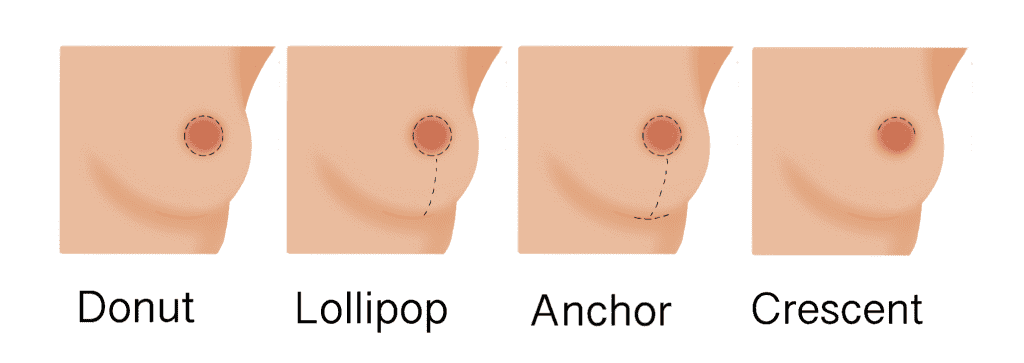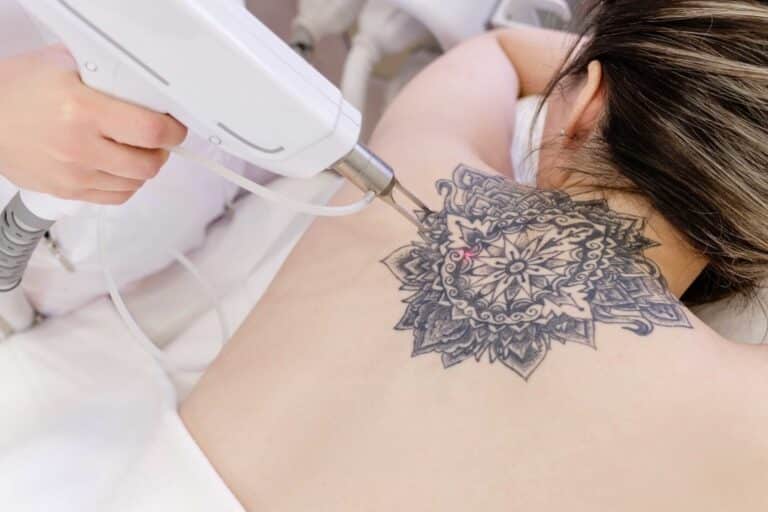Breast Liposuction Scars: Incision Types & Healing Time
Understanding Breast Reduction Scars
Natural Healing
Breast reduction scars are a natural part of the healing process. These scars form due to surgical incisions made during breast reduction surgery. The body repairs the tissue, resulting in scar formation.
Each person’s body heals differently. Some breast reduction patients may have more visible scars, while others might have minimal scarring from a scarless breast reduction procedure.
Surgical Incisions
Surgeons make precise cuts to remove excess breast tissue. This is necessary to achieve the desired breast size and shape, considering operative scars and the scar healing process. The most common incision sites include around the nipple, under the breast fold, and sometimes vertically down from the nipple, which can be influenced by the scar healing process and scar reduction treatments.
The location and type of incision can influence the appearance of scars in breast reduction patients undergoing traditional breast reduction or scarless breast reduction. For instance, a breast fold scar may be less noticeable as it hides under the natural crease of the breast.
Scar Development
Scars change over time as they heal. Initially, breast reduction scars change and they appear red or pink and may feel firm. Over months, they gradually fade and flatten out. This process can take up to a year or longer for breast reduction patients as breast reduction scars change, even with scarless breast reduction.
Factors like genetics, age, skin type, and overall health affect scar development in breast reduction patients, including those undergoing scarless breast reduction. Proper care can also impact how well scars heal.
Healing Process
Healing tissue in breast reduction scars undergoes several stages. Right after surgery, the body starts repairing damaged tissues. New collagen forms to close wounds, creating scars.
During this period, it’s crucial to avoid direct sunlight on scars. UV rays can darken breast reduction scars and make them more noticeable. Using sunscreen or covering scars helps protect them.
Scar Minimization
Several methods exist to minimize breast reduction scars:
- Silicone sheets or gels: These can help flatten and soften scars from scarless breast reduction.
- Massage: Gently massaging the scar area after breast reduction can improve blood flow and reduce stiffness.
- Laser treatments: These can reduce redness and improve texture.
Following your surgeon’s advice on post-operative care is essential for better outcomes, especially regarding your breast reduction scar.
Individual Variability
Not all patients experience the same level of scarring. Some may have minimal breast reduction targets, resulting in fewer scars. Others might need more extensive procedures, such as breast reduction, leading to more noticeable scars.
Understanding that each person’s healing journey is unique, including the appearance of a breast reduction scar, helps set realistic expectations. Comparing breast reduction pictures before and after surgery can provide insight into potential results but remember individual differences play a significant role.
Types of Reduction Scars
Thin Line Scars
Thin line scars are common after breast liposuction. These scars from breast reduction often vary in color from the natural skin tone. They can appear as fine lines on the skin’s surface.
The color of these scars may differ based on individual healing. Some people may see pink or red scars. Others might notice purple, gray, or dark brown lines.
Raised Scars
Raised scars can occur depending on how one heals. These scars are more noticeable than thin line scars. They can feel bumpy to the touch.
e people have a higher chance of developing raised scars. This is due to their body’s unique healing process. Raised scars may remain prominent for a longer period.
Color Variations
Scar colors range widely among individuals. Initially, they might look pink or red. Over time, they can turn darker or lighter.
e scars become purple or gray during healing. Others might stay dark brown. The final color depends on multiple factors like skin type and healing response.
Healing Process
The healing process affects scar appearance. Proper care can help minimize scar visibility. Keeping the area clean and moisturized is essential.
Using silicone sheets or gels may also aid in reducing scar prominence. These products help flatten and soften scars over time.
Scar Treatment Options
Several treatments exist for managing scars. Laser therapy is one option that helps reduce scar redness and thickness. Microneedling can also improve scar texture and appearance.
Topical treatments include creams with vitamin E or onion extract. These ingredients promote better healing and reduce discoloration.
Emotional Impact
Scars can have an emotional impact on individuals. Some feel self-conscious about visible scars. It is important to remember that everyone heals differently.
Support from friends and family can help in coping with scar-related concerns. Consulting a dermatologist may provide additional support and treatment options.
Incision Methods and Scar Patterns
Vertical Incision
The vertical incision, also known as the lollipop incision, is common in breast liposuction. This method involves making a circular cut around the areola and a vertical line down to the breast crease. The resulting scar looks like a lollipop.
This type of incision often results in less noticeable scarring. The scars are usually hidden by the natural folds of the body. However, the size of the scar depends on how much tissue is removed.
Inverted Incision
The inverted incision, or anchor incision, is another method used. This technique involves three cuts: around the areola, vertically down to the breast crease, and along the crease itself. The resulting scar resembles an anchor.
This method can leave more noticeable scars compared to the vertical incision. The larger surface area covered by the cuts makes this type more visible. However, it allows for more extensive reshaping of the breast.
Location and Appearance
The choice between these two methods affects where scars appear and how they look. Vertical incisions tend to leave scars that are less visible due to their placement. They follow natural body lines, making them blend in better.
In contrast, inverted incisions result in more prominent scars. These scars cover a larger area and may be harder to hide. However, this method is often necessary for significant reshaping.
Surgeon’s Technique
A surgeon’s skill plays a crucial role in how noticeable scars will be. Experienced surgeons can minimize scarring through precise techniques. They take care to make clean cuts and use fine sutures.
Patient anatomy also influences the choice of incision type. Factors like skin elasticity and breast size determine which method will be most effective. Surgeons tailor their approach based on each patient’s unique body structure.

Patient Care
Patients can help reduce noticeable scarring by following post-operative care instructions carefully. Keeping incisions clean and avoiding strain on the area aids healing. Using silicone sheets or scar creams may also improve scar appearance over time.
Scar Changes Over Time
Initial Appearance
Scars initially appear red and raised. This is due to the body’s natural healing response. The incision methods discussed earlier impact the initial scar appearance.
Scar Healing Process
Over the first few weeks, scars may look prominent. The scar healing process involves inflammation and collagen production. During this time, scars can be itchy or tender.
Fading and Blending
As months pass, scars start to fade. They gradually blend with the natural skin tone. By six months to a year, significant changes occur. Scars become less noticeable.
Long-Term Changes
Scars continue to evolve over several years. They often become flat and pale. For many, scars are easily covered by clothing after some time.
Risk Factors
e factors affect how scars form and heal:
- Skin type
- Genetics
- Health conditions
- Sun exposure
These factors can influence scar visibility and texture.
Scar Reduction Methods
Several products and techniques help in scar reduction:
- Silicone sheets
- Topical creams
- Massage therapy
- Laser treatments
These methods aim to improve scar appearance over time.
Scar Revision Surgery
In some cases, scar revision surgery may be necessary. This procedure helps improve the scar’s appearance. It is often considered when non-surgical methods are ineffective.
Emotional Impact
Scars can have an emotional impact. Feeling self-conscious about visible scars is common. However, many find comfort as scars fade and become less noticeable.
Scar Duration and Visibility
Permanent Yet Fading
Scars from breast liposuction are permanent. However, their visibility can significantly decrease over time. This is due to the natural healing process of the body. Initially, scars may appear red or dark. Over months and years, they often fade to a lighter color.
Factors Influencing Scars
Several factors influence scar duration and visibility. Skin type plays a crucial role. People with darker skin may notice hyperpigmentation. Those with fair skin might see redness for longer periods.
The care regimen also impacts scar appearance. Keeping the area clean prevents infection. Moisturizing helps maintain skin elasticity. Sun protection is vital since UV rays can darken scars.
Importance of Post-Operative Care
Proper post-operative care enhances the healing process. Following your surgeon’s instructions is key. Use prescribed ointments to aid recovery. Avoid strenuous activities that could stress the wound.
Real-Life Experiences
Many patients report significant improvements with diligent care. For instance, Jane, a 35-year-old patient, saw her scars fade within a year by following her doctor’s advice strictly. She used silicone sheets and avoided sun exposure religiously.
Timeline of Healing
Typically, the most noticeable changes occur in the first six months. By this time, swelling reduces and the scar begins to lighten. Over the next year, continuous improvement is common.
Emotional Impact
Visible scars can have an emotional impact. Feeling self-conscious is normal initially. Support groups can provide comfort and shared experiences. Knowing others have similar concerns can be reassuring.
Minimizing Scar Tissue
Post-Surgery Treatments
Following breast liposuction, specific treatments can help minimize scar tissue. Silicone sheets and gels are effective. They keep the skin hydrated, which helps reduce scar formation. Apply them as soon as the incision heals. Use them daily for several months.
Massage is another helpful method. Gently massaging the scar area breaks down dense tissue. This promotes healing and reduces scar visibility. Start massage therapy a few weeks after surgery.
Aftercare Instructions
Adhering to the surgeon’s aftercare instructions is crucial. Proper care prevents complications and improves healing. Keep the wound clean and dry in the initial days post-surgery. Avoid strenuous activities that may strain the area.
Follow-up appointments are essential. They allow the surgeon to monitor healing progress. Any signs of infection or abnormal scarring can be addressed promptly.
Silicone Sheets and Gels
Silicone sheets are easy to use. Cut them to fit over the scar and apply directly to the skin. These sheets provide constant pressure, which helps flatten scars over time.
Silicone gels are equally effective. Apply a thin layer over the scar once it heals. The gel forms a protective barrier, keeping moisture in and bacteria out.
Massage
Scar massage should be done gently. Use circular motions around the scar area. This helps break down the fibrous tissue that forms scars.
Start with light pressure and gradually increase it as tolerated. Perform massage two to three times daily for best results.
Sun Protection
Protecting scars from sun exposure is vital. UV rays can darken scars, making them more noticeable. Use sunscreen with at least SPF 30 on exposed scars.
Wear protective clothing when outdoors. Hats and long sleeves offer additional protection against harmful rays.
Short Scar Techniques
Short scar techniques offer a way to reduce visible scarring in breast reduction surgery. These methods use fewer and smaller incisions. This results in less noticeable scars.
Fewer Incisions
Surgeons make fewer incisions with short scar techniques. The goal is to minimize the amount of scarring. By making only the necessary cuts, the skin heals better. Smaller incisions mean less trauma to the tissue. This often leads to quicker recovery times.
Smaller Scars
The incisions are also smaller in size. Smaller cuts leave behind smaller scars. This is beneficial for patients who are concerned about visible marks. The scar reduction techniques focus on achieving a natural look. Many patients find this appealing.
Patient Suitability
Not all patients can use short scar techniques. Factors like breast size and desired reduction play a role. Larger breasts may need more extensive surgery. This could mean more or larger incisions are necessary. Surgeons evaluate each patient individually.
Real-Life Examples
Many women have shared their experiences with short scar techniques. For some, the results were life-changing. They felt more confident and happy with their appearance. Others found that the smaller scars were barely noticeable after healing.
Technical Details
There are several types of short scar techniques:
- Vertical Scar Technique: Uses a single vertical incision.
- Lollipop Technique: Combines a vertical incision with a small circular cut around the nipple.
- Donut Technique: Involves an incision around the nipple only.
Each technique aims to reduce scarring while achieving the desired breast shape.
Surgeon Expertise
The success of these techniques depends on the surgeon’s skill. Experienced surgeons can make precise cuts that heal well. Choosing a qualified surgeon is crucial for good results.
Alternative Scar Treatments
Laser Therapy
Laser therapy is a popular method for treating scars. It uses focused light to reduce the appearance of scars. This treatment can improve the texture and color of the skin.
Benefits include minimal downtime and non-invasive nature. However, multiple sessions may be required. Limitations are potential side effects like redness or swelling.
Microneedling
Microneedling involves tiny needles creating micro-injuries in the skin. This process stimulates collagen production. Increased collagen helps improve the appearance of scars.
Benefits include enhanced skin texture and reduced scar visibility. The procedure is relatively quick. Limitations are temporary discomfort and possible minor bleeding.
Steroid Injections
Steroid injections are another option for scar reduction. They work by reducing inflammation and flattening raised scars. This method is often used for keloid or hypertrophic scars.
Benefits include effectiveness in reducing thick scars. The treatment is quick and can be done in a doctor’s office. Limitations are potential side effects like skin thinning or discoloration.
Silicone Sheets
Silicone sheets are applied directly to the scar area. They help hydrate the skin and reduce scar thickness over time. These sheets can be worn under clothing.
Benefits include ease of use and non-invasive nature. They can be worn throughout the day. Limitations are that they require consistent use over several months for noticeable results.
Chemical Peels
Chemical peels involve applying a chemical solution to the skin. This solution removes the top layer of skin, promoting new skin growth. This can help minimize the appearance of scars.
Benefits include improved skin texture and tone. The procedure is relatively quick. Limitations are potential irritation and peeling post-treatment.
Cryotherapy
Cryotherapy uses extreme cold to freeze scar tissue. This method is often used for smaller scars or keloids. The freezing process helps reduce scar size and visibility.
Benefits include effectiveness in shrinking thick scars. The procedure is usually quick. Limitations are possible blistering and temporary discomfort.
Consult a Specialist
Consulting with a dermatologist or plastic surgeon is crucial before starting any treatment plan. Specialists can assess your specific needs and recommend the best options for you.
Choosing a Qualified Surgeon
Board-Certified Surgeon
Select a board-certified plastic surgeon. They have the proper training and credentials. The American Board of Plastic Surgery certifies these surgeons. This certification ensures they meet high standards.
Experienced surgeons in breast reduction surgery are crucial. They know how to minimize scars. Their expertise can lead to better outcomes. Always verify their certification status.
Before-and-After Photos
Review before-and-after photos of previous surgeries. These photos show the surgeon’s skill. Look for consistency in results. Pay attention to scar patterns and healing.
Photos provide insight into what you can expect. They help set realistic expectations. Compare different surgeons’ work to find the best match.
Multiple Consultations
Consult with multiple surgeons before deciding. Each surgeon may have different techniques and approaches. Discuss your goals and concerns during these meetings.
Ask about the procedure details, potential complications, and recovery time. Inquire about post-operative scar care. Understanding each surgeon’s method helps make an informed choice.
Discuss Techniques
During consultations, discuss surgical techniques used for reducing scars. Some methods are less invasive than others. Surgeons might use different incision patterns.
Common incision patterns include:
- Anchor pattern: Used for significant reductions.
- Lollipop pattern: Less scarring, suitable for moderate reductions.
- Donut pattern: Minimal scarring, for minor reductions.
Choose a technique that aligns with your needs and preferences.
Post-Operative Care
Post-operative care is vital for minimizing scars. Follow the surgeon’s advice strictly. Proper care reduces the risk of complications.
Discuss scar treatment options during consultations. Some treatments include silicone sheets or gels, massage, and laser therapy. These can improve scar appearance over time.
Clinic Environment
The clinic environment also matters. Choose a clinic with a good reputation. Ensure it meets safety standards and has modern equipment.
A well-equipped clinic contributes to better outcomes. It also ensures your safety during the procedure.
Closing Thoughts
Breast liposuction scars can be a concern, but understanding them helps you manage expectations. By knowing the types, patterns, and changes over time, you can make informed decisions. Scar visibility varies, but with proper care and techniques, you can minimize their appearance.
Choosing a qualified surgeon is crucial. Their expertise ensures better outcomes and less noticeable scars. Ready to take control of your scar management? Consult with a specialist today and explore your options. Your journey to confidence starts now.
Frequently Asked Questions
What are the common types of breast reduction scars?
The common types of breast reduction scars include anchor, lollipop, and donut patterns. Each type is based on the incision method used during surgery.
How do incision methods affect scar patterns?
Incision methods determine scar patterns. For example, an anchor incision results in more noticeable scars compared to a donut incision which is less invasive.
How long do breast reduction scars last?
Breast reduction scars can last from several months to a few years. They typically fade over time but may never completely disappear.
Can scar tissue be minimized after breast reduction surgery?
Yes, scar tissue can be minimized with proper care. Using silicone sheets, scar creams, and following your surgeon’s post-op instructions can help reduce scarring.
What are short scar techniques in breast reduction?
Short scar techniques involve less invasive incisions. These methods aim to minimize visible scarring while achieving effective breast reduction results.
Are there alternative treatments for reducing scars?
Yes, alternative treatments like laser therapy, microneedling, and steroid injections can help reduce the appearance of scars after breast reduction surgery.
Why is it important to choose a qualified surgeon for breast reduction?
A qualified surgeon ensures safe procedures and optimal results. Their expertise minimizes complications and improves the aesthetic outcomes of your surgery.





